| |
Budapest 2011 |
 |
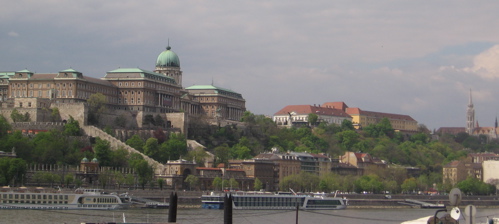 Around ten years ago I did a weekend-trip to Budapest from Vienna with just one night in town - which never felt long enough to explore this town properly. And what was worse: After fifty years of communist rule Budapest, especially the modern city center of Pest (on the Danube's right bank), was terribly run-down and dirty and offered only glimpses of what the town must have looked like decades ago when it was dubbed "Paris of the East". So now felt the right time to finally return and see how much Budapest has scrubbed up in the intervening years - and this time a proper city trip by plane and a total of three nights in town.
Around ten years ago I did a weekend-trip to Budapest from Vienna with just one night in town - which never felt long enough to explore this town properly. And what was worse: After fifty years of communist rule Budapest, especially the modern city center of Pest (on the Danube's right bank), was terribly run-down and dirty and offered only glimpses of what the town must have looked like decades ago when it was dubbed "Paris of the East". So now felt the right time to finally return and see how much Budapest has scrubbed up in the intervening years - and this time a proper city trip by plane and a total of three nights in town.
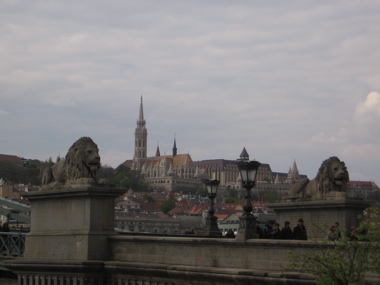 |
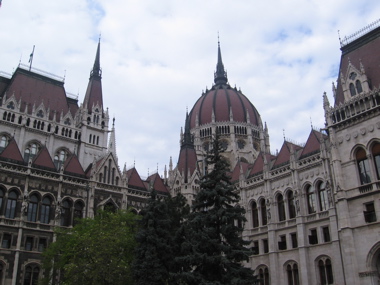 |
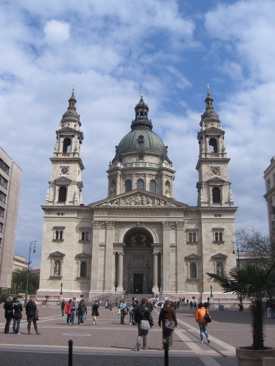 We flew Germanwings to Budapest Ferihegy Airport, where the bargain airlines now occupy the old terminal 1, while Malev and the other swish airlines moved to a fancy new terminal so far away I never even saw it. From there it was a half-hour taxi ride to our hotel in the 7th district, Erzsebetváros, the old Jewish quarter, which is currently being refurbished wholesale (since Hungary, unlike our brethren in East-Germany, doesn't have a rich western brother whose pockets they can shamelessly fleece for thirty years, they have to carry out large-scale refurbishment bit by bit).
We flew Germanwings to Budapest Ferihegy Airport, where the bargain airlines now occupy the old terminal 1, while Malev and the other swish airlines moved to a fancy new terminal so far away I never even saw it. From there it was a half-hour taxi ride to our hotel in the 7th district, Erzsebetváros, the old Jewish quarter, which is currently being refurbished wholesale (since Hungary, unlike our brethren in East-Germany, doesn't have a rich western brother whose pockets they can shamelessly fleece for thirty years, they have to carry out large-scale refurbishment bit by bit).
And since we couldn't yet check in, we went for a walk around Pest and along the Danube to the amazing Parliament building that must rank right up with Westminster as an overblown fancy palace. We stopped to visit St.István's Basilica, dedicated to Hungary's founder, Saint Stephen, whose right hand is still being kept there on display as a relic. While that was a bit on the iffy side, the basilica itself is definitely gorgeous to look at. Finally we crashed for refreshments at one of Budapest's old gorgeous coffee houses, the Gerbeaud, and befpre returning to the hotel via Andrássy Utca, the tree-lined boulevard that, inevitably, gets called Budapest's Champs Elysées. After checking in and a break, we were off again to have dinner on leafy little Ferenc Liszt Tér (Franz Liszt Square to most of you) before spending the evening to see "Jesus Christ Superstar" at the Madách-Theatre. Which was very good and very loud. And sung in Hungarian. But hey.
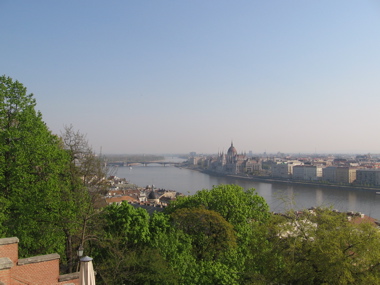 While Pest had impressed me by having scrubbed up really well, Buda doesn't need much scrubbing. In fact the old city on top of the hill with its perfectly preserved ancient houses on quaint little streets sometimes gets pressed into service to figure as 19th century European cities in historical movies! Since a lot of walking would be on the cards, we took the cute little "Siklo" uphill (see down left), then walked around the castle first and visited the rather lame historical museum, which didn't give access to any prettily furnished castle rooms. Instead you get four floors of mostly just stones from various periods, taken from the medieval castles that stood on the site before the present one was built atop it. Among the more curious statues strewn all over the castle is the black crow with a golden ring in its beak that guards the entrance - apparently King Matyas (Matthew) chose the crow for his heraldic sign after one stole a ring from him and he had to kill it to get the ring back. And I'm not sure who the fellow on the right hand photo is, but it boggled me to see this statue since normally all national heros are depicted ON TOP of their horses.
Situated next to the castle is the old town that shares Buda hill with the castle - here's a nice picture of one of the quaint old streets and one of the Fisherman's Bastion - which isn't half as old as you'd think: It was created at the end of 19th century as a pretty "closing link" between the Matyas Church on top of the hill and the street leading up to it. Its name honours the fishermen who used to live in this area.
While Pest had impressed me by having scrubbed up really well, Buda doesn't need much scrubbing. In fact the old city on top of the hill with its perfectly preserved ancient houses on quaint little streets sometimes gets pressed into service to figure as 19th century European cities in historical movies! Since a lot of walking would be on the cards, we took the cute little "Siklo" uphill (see down left), then walked around the castle first and visited the rather lame historical museum, which didn't give access to any prettily furnished castle rooms. Instead you get four floors of mostly just stones from various periods, taken from the medieval castles that stood on the site before the present one was built atop it. Among the more curious statues strewn all over the castle is the black crow with a golden ring in its beak that guards the entrance - apparently King Matyas (Matthew) chose the crow for his heraldic sign after one stole a ring from him and he had to kill it to get the ring back. And I'm not sure who the fellow on the right hand photo is, but it boggled me to see this statue since normally all national heros are depicted ON TOP of their horses.
Situated next to the castle is the old town that shares Buda hill with the castle - here's a nice picture of one of the quaint old streets and one of the Fisherman's Bastion - which isn't half as old as you'd think: It was created at the end of 19th century as a pretty "closing link" between the Matyas Church on top of the hill and the street leading up to it. Its name honours the fishermen who used to live in this area.
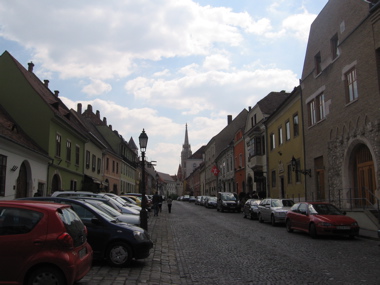 |
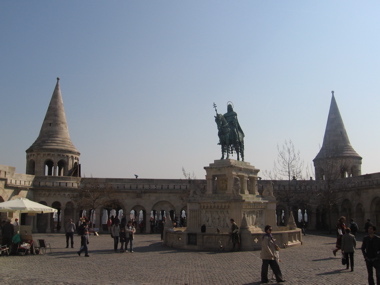 |
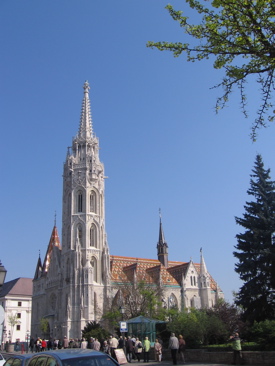 |
The Matyas Church, also named for King Matyas, is Budapest's most famous church, where the Hungarian kings were crowned for many centuries, including Austria's Emperor Franz Joseph and his dear Sisi, Empress Elisabeth, when they agreed to give Hungary some autonomy back and form the "double monarchy" of Austria-Hungary in 19th century.
It doesn't open for tourists till 1pm on Sundays to give churchgoers a chance to worship in peace, which I appreciated. And the church was definitely worth the wait to see the spectacular interior, with its walls completely painted in pretty murals. And an old catholic customs was well and truly alive in Hungary too: In the week before Easter, the cross is covered with black cloth everywhere - to be removed on Easter Sunday. |
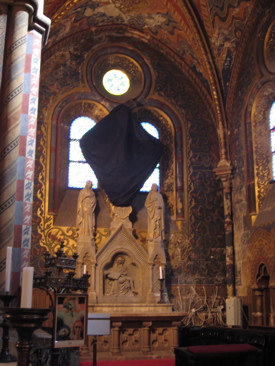 |
And here's another picture of the altar room of the Matyas Church and the view from the hill across the Chain Bridge towards St.István's Basilica on the Pest side, before we started the long walk downhill.
It wasn't the only hill we tackled that day - and sadly, the Gellért Hill didn't have a nice little funicular to take us uphill, so we had to climb several hundred steps of doom to the Citadel to be rewarded with the gorgeous view all over town and the Danube.
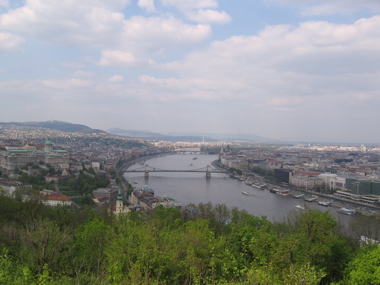 The Gellért in question who didn't only have this fancy monument (left) named for him but also the entire hill, a fancy hotel and one of the most gorgeous baths in town, was a Venetian missionary who tried to christianize the medieval Magyars and was rewarded for his trouble by them throwing him down the hill in a spiked barrel.
The Gellért in question who didn't only have this fancy monument (left) named for him but also the entire hill, a fancy hotel and one of the most gorgeous baths in town, was a Venetian missionary who tried to christianize the medieval Magyars and was rewarded for his trouble by them throwing him down the hill in a spiked barrel.
The Citadel on top of the hill was built in 19th century only and is mostly known now for the gorgeous view it offers across town, especially in the evening, when a million lights sparkle on both sides of the river and the old buildings are beautifully lit. Since it won't get dark till nine in April, we decided to forego that pleasure though. Another sight up there is the Statue of Liberty that is visible from pretty much everywhere in the city. It was erected after WWII as a memorial, but since it was -also- a memorial of the period of Soviet occupation, many Hungarians would now rather see it gone.
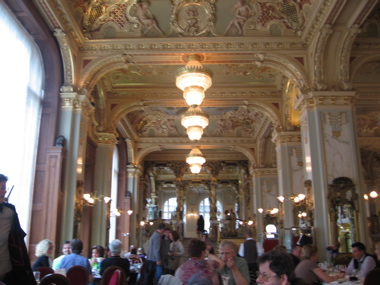
Naturally, after all that trudging up and down hills, we needed a reward and what better reward than another of Budapest's awesome desserts, this time at the New York Coffee House, whose palace-like interior needs to be seen to be believed. It was here Budapest's literary elite hung out at the turn of the century. Makes a plain coffee taste twice as good - and of course for twice the price as everywhere else. From there it was back to the hotel for some much needed chilling in the nice hotel pool on the roof and the jacuzzis before returning to Liszt-Square for another nice outdoor meal in that leafy little square. While it's admittedly a bit of a tourist trap, it was definitely my favorite area in Budapest.
We definitely wanted to take it easy on the last day. So we took the "Földalatti" up to the park - the Metro line 1, which was in its time (late 19th century) the first European subway train to run on electricity, while London's underground was still clogging up the tunnels with steam. The stations are still pure Art Nouveau and make the ride a sight in its own right. We got off at "Heros' Square" where all of Hungary's greatest heros and kings are assembled (the Hungarians dearly love to commemorate people and events). Around the corner is Vadjahunyad Castle, a rather bizarre concoction made up of imitations of some of Hungary's most famous castles all stitched into one. From there we were off to the Széchenyi Baths, another of Budapest's famous spas with its incredible late 19th century-design. What I totally adored were the private little changing cabins (that also looked like they dated from 19th century) which you hire for the day to leave your stuff in:
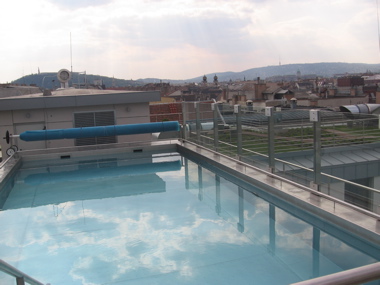 However, I have to be honest: Given the choice between the gorgeous huge baths, crowded with mostly elderly folks, many of whom apparently German pensioners on health tourism in Hungary (and not above nudging you away from a gushing fountain of massaging jet water when they think you hogged it long enough) and the privacy of our own little pool on the hotel roof top... the hotelpool won hands down. So after just two hours or so we upped sticks in the Széchenyi Baths again to return to the hotel and the pool for some more time, enjoying the unexpected early-summer weather with a glorious sun shining over Budapest.
However, I have to be honest: Given the choice between the gorgeous huge baths, crowded with mostly elderly folks, many of whom apparently German pensioners on health tourism in Hungary (and not above nudging you away from a gushing fountain of massaging jet water when they think you hogged it long enough) and the privacy of our own little pool on the hotel roof top... the hotelpool won hands down. So after just two hours or so we upped sticks in the Széchenyi Baths again to return to the hotel and the pool for some more time, enjoying the unexpected early-summer weather with a glorious sun shining over Budapest.
Finally we headed down into Pest again for some shopping on Vaci Utca (which was a bit of a disappointment, housing precisely the same global clothes shops we got in every German town) before a last dinner.
I did enjoy seeing Budapest again - and to finally be able to catch a musical here and ot visit one of the famous Spas. Pest has certainly scrubbed up quite a bit already but they still have a long way to go.

 Around ten years ago I did a weekend-trip to Budapest from Vienna with just one night in town - which never felt long enough to explore this town properly. And what was worse: After fifty years of communist rule Budapest, especially the modern city center of Pest (on the Danube's right bank), was terribly run-down and dirty and offered only glimpses of what the town must have looked like decades ago when it was dubbed "Paris of the East". So now felt the right time to finally return and see how much Budapest has scrubbed up in the intervening years - and this time a proper city trip by plane and a total of three nights in town.
Around ten years ago I did a weekend-trip to Budapest from Vienna with just one night in town - which never felt long enough to explore this town properly. And what was worse: After fifty years of communist rule Budapest, especially the modern city center of Pest (on the Danube's right bank), was terribly run-down and dirty and offered only glimpses of what the town must have looked like decades ago when it was dubbed "Paris of the East". So now felt the right time to finally return and see how much Budapest has scrubbed up in the intervening years - and this time a proper city trip by plane and a total of three nights in town.

 We flew Germanwings to Budapest Ferihegy Airport, where the bargain airlines now occupy the old terminal 1, while Malev and the other swish airlines moved to a fancy new terminal so far away I never even saw it. From there it was a half-hour taxi ride to our hotel in the 7th district, Erzsebetváros, the old Jewish quarter, which is currently being refurbished wholesale (since Hungary, unlike our brethren in East-Germany, doesn't have a rich western brother whose pockets they can shamelessly fleece for thirty years, they have to carry out large-scale refurbishment bit by bit).
We flew Germanwings to Budapest Ferihegy Airport, where the bargain airlines now occupy the old terminal 1, while Malev and the other swish airlines moved to a fancy new terminal so far away I never even saw it. From there it was a half-hour taxi ride to our hotel in the 7th district, Erzsebetváros, the old Jewish quarter, which is currently being refurbished wholesale (since Hungary, unlike our brethren in East-Germany, doesn't have a rich western brother whose pockets they can shamelessly fleece for thirty years, they have to carry out large-scale refurbishment bit by bit). While Pest had impressed me by having scrubbed up really well, Buda doesn't need much scrubbing. In fact the old city on top of the hill with its perfectly preserved ancient houses on quaint little streets sometimes gets pressed into service to figure as 19th century European cities in historical movies! Since a lot of walking would be on the cards, we took the cute little "Siklo" uphill (see down left), then walked around the castle first and visited the rather lame historical museum, which didn't give access to any prettily furnished castle rooms. Instead you get four floors of mostly just stones from various periods, taken from the medieval castles that stood on the site before the present one was built atop it. Among the more curious statues strewn all over the castle is the black crow with a golden ring in its beak that guards the entrance - apparently King Matyas (Matthew) chose the crow for his heraldic sign after one stole a ring from him and he had to kill it to get the ring back. And I'm not sure who the fellow on the right hand photo is, but it boggled me to see this statue since normally all national heros are depicted ON TOP of their horses.
While Pest had impressed me by having scrubbed up really well, Buda doesn't need much scrubbing. In fact the old city on top of the hill with its perfectly preserved ancient houses on quaint little streets sometimes gets pressed into service to figure as 19th century European cities in historical movies! Since a lot of walking would be on the cards, we took the cute little "Siklo" uphill (see down left), then walked around the castle first and visited the rather lame historical museum, which didn't give access to any prettily furnished castle rooms. Instead you get four floors of mostly just stones from various periods, taken from the medieval castles that stood on the site before the present one was built atop it. Among the more curious statues strewn all over the castle is the black crow with a golden ring in its beak that guards the entrance - apparently King Matyas (Matthew) chose the crow for his heraldic sign after one stole a ring from him and he had to kill it to get the ring back. And I'm not sure who the fellow on the right hand photo is, but it boggled me to see this statue since normally all national heros are depicted ON TOP of their horses.
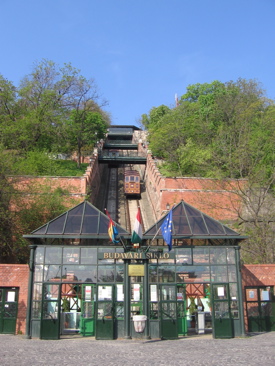
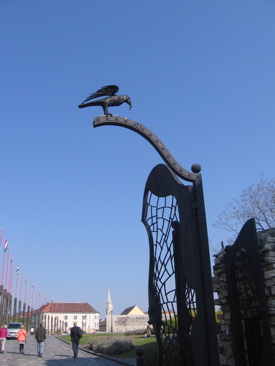
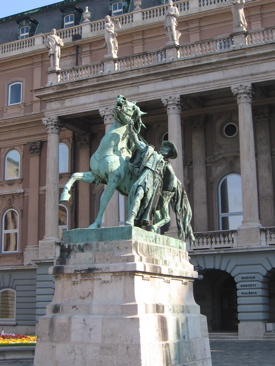




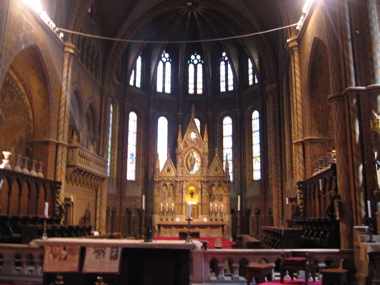
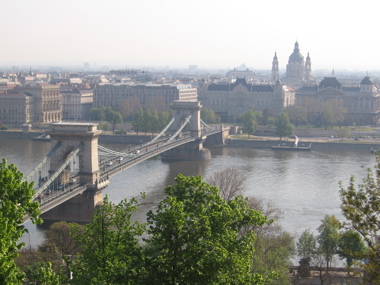
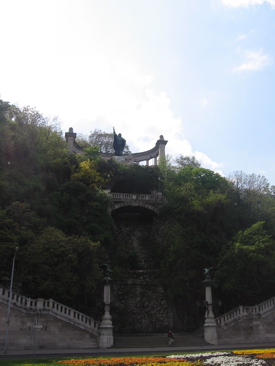
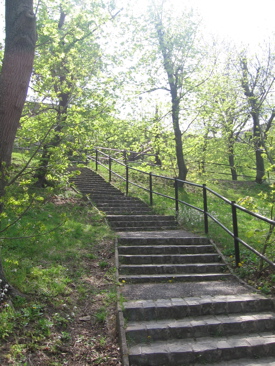
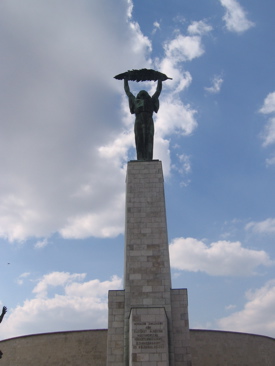
 The Gellért in question who didn't only have this fancy monument (left) named for him but also the entire hill, a fancy hotel and one of the most gorgeous baths in town, was a Venetian missionary who tried to christianize the medieval Magyars and was rewarded for his trouble by them throwing him down the hill in a spiked barrel.
The Gellért in question who didn't only have this fancy monument (left) named for him but also the entire hill, a fancy hotel and one of the most gorgeous baths in town, was a Venetian missionary who tried to christianize the medieval Magyars and was rewarded for his trouble by them throwing him down the hill in a spiked barrel. 
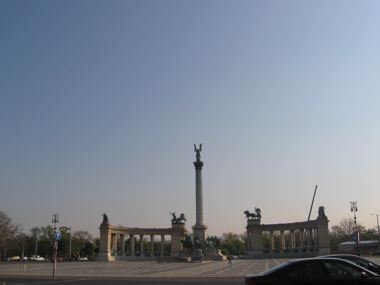
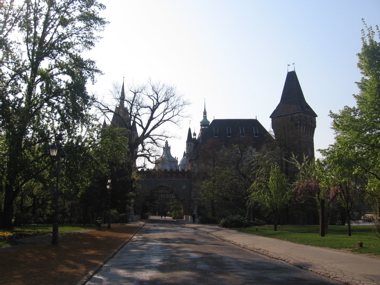
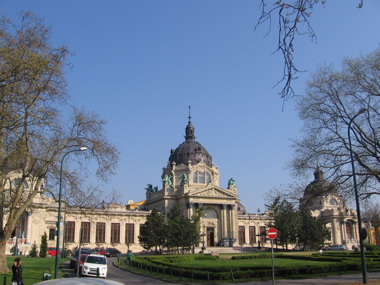
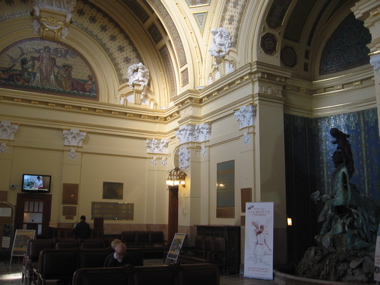
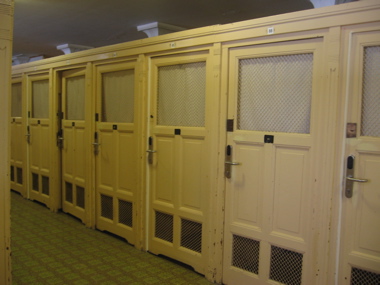
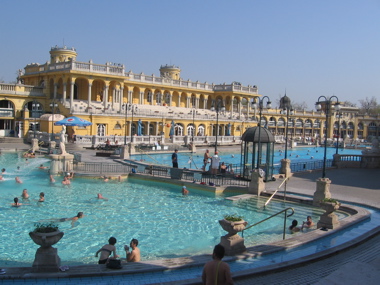
 However, I have to be honest: Given the choice between the gorgeous huge baths, crowded with mostly elderly folks, many of whom apparently German pensioners on health tourism in Hungary (and not above nudging you away from a gushing fountain of massaging jet water when they think you hogged it long enough) and the privacy of our own little pool on the hotel roof top... the hotelpool won hands down. So after just two hours or so we upped sticks in the Széchenyi Baths again to return to the hotel and the pool for some more time, enjoying the unexpected early-summer weather with a glorious sun shining over Budapest.
However, I have to be honest: Given the choice between the gorgeous huge baths, crowded with mostly elderly folks, many of whom apparently German pensioners on health tourism in Hungary (and not above nudging you away from a gushing fountain of massaging jet water when they think you hogged it long enough) and the privacy of our own little pool on the hotel roof top... the hotelpool won hands down. So after just two hours or so we upped sticks in the Széchenyi Baths again to return to the hotel and the pool for some more time, enjoying the unexpected early-summer weather with a glorious sun shining over Budapest.